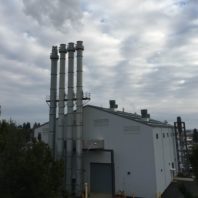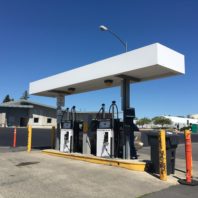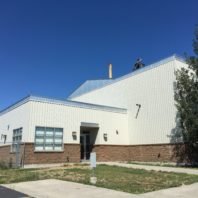Accordion and folding content blocks
accordion `.accordion`
Past Projects
 WSU commissioned a new steam plant in 2004 which utilizes natural gas instead of coal as its main fuel source lowering the University’s carbon dioxide equivalent emissions by more than 25,000 metric tons annually. Compared to 1990 emissions, WSU has reduced its criteria pollutant emissions significantly. Annual nitrous oxide emissions have been reduced by 97% (350 metric tons); sulfur dioxide emissions have been reduced by 99.9% (550 metric tons); carbon monoxide emissions have been reduced by 99% (45 metric tons); particulate matter emissions have been reduced by 90% (30 metric tons). Since signing the President’s Climate Commitment in 2007, WSU continues to lower its greenhouse gas and criteria pollutant emissions.
WSU commissioned a new steam plant in 2004 which utilizes natural gas instead of coal as its main fuel source lowering the University’s carbon dioxide equivalent emissions by more than 25,000 metric tons annually. Compared to 1990 emissions, WSU has reduced its criteria pollutant emissions significantly. Annual nitrous oxide emissions have been reduced by 97% (350 metric tons); sulfur dioxide emissions have been reduced by 99.9% (550 metric tons); carbon monoxide emissions have been reduced by 99% (45 metric tons); particulate matter emissions have been reduced by 90% (30 metric tons). Since signing the President’s Climate Commitment in 2007, WSU continues to lower its greenhouse gas and criteria pollutant emissions.
Current Projects
 WSU’s campus fleet uses alternative fuel. We have switched to B5, which is diesel containing 5% biofuel for use in the winter. During the summer, we use B10, which is diesel containing 10% biofuel. We have evaluated fuel with greater concentrations of biofuel, but currently there is not a feasible outlet regionally that meets WSU’s needs. Also, our climate deters the switch to higher concentrations of biofuel because of the properties of biofuel in colder weather conditions.
WSU’s campus fleet uses alternative fuel. We have switched to B5, which is diesel containing 5% biofuel for use in the winter. During the summer, we use B10, which is diesel containing 10% biofuel. We have evaluated fuel with greater concentrations of biofuel, but currently there is not a feasible outlet regionally that meets WSU’s needs. Also, our climate deters the switch to higher concentrations of biofuel because of the properties of biofuel in colder weather conditions.
folding `.folding`
Past Projects
 WSU’s campus fleet uses alternative fuel. We have switched to B5, which is diesel containing 5% biofuel for use in the winter. During the summer, we use B10, which is diesel containing 10% biofuel. We have evaluated fuel with greater concentrations of biofuel, but currently there is not a feasible outlet regionally that meets WSU’s needs. Also, our climate deters the switch to higher concentrations of biofuel because of the properties of biofuel in colder weather conditions.
WSU’s campus fleet uses alternative fuel. We have switched to B5, which is diesel containing 5% biofuel for use in the winter. During the summer, we use B10, which is diesel containing 10% biofuel. We have evaluated fuel with greater concentrations of biofuel, but currently there is not a feasible outlet regionally that meets WSU’s needs. Also, our climate deters the switch to higher concentrations of biofuel because of the properties of biofuel in colder weather conditions.
Current Projects
 WSU’s campus fleet uses alternative fuel. We have switched to B5, which is diesel containing 5% biofuel for use in the winter. During the summer, we use B10, which is diesel containing 10% biofuel. We have evaluated fuel with greater concentrations of biofuel, but currently there is not a feasible outlet regionally that meets WSU’s needs. Also, our climate deters the switch to higher concentrations of biofuel because of the properties of biofuel in colder weather conditions.
WSU’s campus fleet uses alternative fuel. We have switched to B5, which is diesel containing 5% biofuel for use in the winter. During the summer, we use B10, which is diesel containing 10% biofuel. We have evaluated fuel with greater concentrations of biofuel, but currently there is not a feasible outlet regionally that meets WSU’s needs. Also, our climate deters the switch to higher concentrations of biofuel because of the properties of biofuel in colder weather conditions.
folding `.folding.as-more`
Past Projects
 WSU commissioned a new steam plant in 2004 which utilizes natural gas instead of coal as its main fuel source lowering the University’s carbon dioxide equivalent emissions by more than 25,000 metric tons annually. Compared to 1990 emissions, WSU has reduced its criteria pollutant emissions significantly. Annual nitrous oxide emissions have been reduced by 97% (350 metric tons); sulfur dioxide emissions have been reduced by 99.9% (550 metric tons); carbon monoxide emissions have been reduced by 99% (45 metric tons); particulate matter emissions have been reduced by 90% (30 metric tons). Since signing the President’s Climate Commitment in 2007, WSU continues to lower its greenhouse gas and criteria pollutant emissions.
WSU commissioned a new steam plant in 2004 which utilizes natural gas instead of coal as its main fuel source lowering the University’s carbon dioxide equivalent emissions by more than 25,000 metric tons annually. Compared to 1990 emissions, WSU has reduced its criteria pollutant emissions significantly. Annual nitrous oxide emissions have been reduced by 97% (350 metric tons); sulfur dioxide emissions have been reduced by 99.9% (550 metric tons); carbon monoxide emissions have been reduced by 99% (45 metric tons); particulate matter emissions have been reduced by 90% (30 metric tons). Since signing the President’s Climate Commitment in 2007, WSU continues to lower its greenhouse gas and criteria pollutant emissions.
Current Projects
 We installed additional air pollution controls on our pathological incinerator in 2014. The opacity readings have been reduced by approximately 3 percent indicating a reduction of lead and particulate emissions. Not only did this meet the new regulatory requirements, but also put our emissions well below the established parameters.
We installed additional air pollution controls on our pathological incinerator in 2014. The opacity readings have been reduced by approximately 3 percent indicating a reduction of lead and particulate emissions. Not only did this meet the new regulatory requirements, but also put our emissions well below the established parameters.
Note:
Accordions may not be necessary if the content is less than one page fold.
folding `.folding.as-more` as `h5 + div`
Past Projects
 WSU’s campus fleet uses alternative fuel. We have switched to B5, which is diesel containing 5% biofuel for use in the winter. During the summer, we use B10, which is diesel containing 10% biofuel. We have evaluated fuel with greater concentrations of biofuel, but currently there is not a feasible outlet regionally that meets WSU’s needs. Also, our climate deters the switch to higher concentrations of biofuel because of the properties of biofuel in colder weather conditions.
WSU’s campus fleet uses alternative fuel. We have switched to B5, which is diesel containing 5% biofuel for use in the winter. During the summer, we use B10, which is diesel containing 10% biofuel. We have evaluated fuel with greater concentrations of biofuel, but currently there is not a feasible outlet regionally that meets WSU’s needs. Also, our climate deters the switch to higher concentrations of biofuel because of the properties of biofuel in colder weather conditions.
Current Projects
 WSU’s campus fleet uses alternative fuel. We have switched to B5, which is diesel containing 5% biofuel for use in the winter. During the summer, we use B10, which is diesel containing 10% biofuel. We have evaluated fuel with greater concentrations of biofuel, but currently there is not a feasible outlet regionally that meets WSU’s needs. Also, our climate deters the switch to higher concentrations of biofuel because of the properties of biofuel in colder weather conditions.
WSU’s campus fleet uses alternative fuel. We have switched to B5, which is diesel containing 5% biofuel for use in the winter. During the summer, we use B10, which is diesel containing 10% biofuel. We have evaluated fuel with greater concentrations of biofuel, but currently there is not a feasible outlet regionally that meets WSU’s needs. Also, our climate deters the switch to higher concentrations of biofuel because of the properties of biofuel in colder weather conditions.
accordion `.accordion` as `h4 + div`
THIS WILL BE A FAIL!!
Past Projects
 WSU commissioned a new steam plant in 2004 which utilizes natural gas instead of coal as its main fuel source lowering the University’s carbon dioxide equivalent emissions by more than 25,000 metric tons annually. Compared to 1990 emissions, WSU has reduced its criteria pollutant emissions significantly. Annual nitrous oxide emissions have been reduced by 97% (350 metric tons); sulfur dioxide emissions have been reduced by 99.9% (550 metric tons); carbon monoxide emissions have been reduced by 99% (45 metric tons); particulate matter emissions have been reduced by 90% (30 metric tons). Since signing the President’s Climate Commitment in 2007, WSU continues to lower its greenhouse gas and criteria pollutant emissions.
WSU commissioned a new steam plant in 2004 which utilizes natural gas instead of coal as its main fuel source lowering the University’s carbon dioxide equivalent emissions by more than 25,000 metric tons annually. Compared to 1990 emissions, WSU has reduced its criteria pollutant emissions significantly. Annual nitrous oxide emissions have been reduced by 97% (350 metric tons); sulfur dioxide emissions have been reduced by 99.9% (550 metric tons); carbon monoxide emissions have been reduced by 99% (45 metric tons); particulate matter emissions have been reduced by 90% (30 metric tons). Since signing the President’s Climate Commitment in 2007, WSU continues to lower its greenhouse gas and criteria pollutant emissions.
Current Projects
 WSU’s campus fleet uses alternative fuel. We have switched to B5, which is diesel containing 5% biofuel for use in the winter. During the summer, we use B10, which is diesel containing 10% biofuel. We have evaluated fuel with greater concentrations of biofuel, but currently there is not a feasible outlet regionally that meets WSU’s needs. Also, our climate deters the switch to higher concentrations of biofuel because of the properties of biofuel in colder weather conditions.
WSU’s campus fleet uses alternative fuel. We have switched to B5, which is diesel containing 5% biofuel for use in the winter. During the summer, we use B10, which is diesel containing 10% biofuel. We have evaluated fuel with greater concentrations of biofuel, but currently there is not a feasible outlet regionally that meets WSU’s needs. Also, our climate deters the switch to higher concentrations of biofuel because of the properties of biofuel in colder weather conditions.
Buttons
Buttons are an effective way to let the User know that you want them to click in a specific location.
Accordions using the WordPress UI!
This is an example of what the accordion will look like after we are done creating it inside WordPress.
Seen at the Transportation department’s Zimride page.

This can also be done using the UI!
For usability we want the first accordion to be open by default when the page loads. To do this using the WordPress editor we need to setup a couple more pieces.
The following classes need to be added to the specific column.
Step 1)
Create the content container for the accordion.

Step 2)
Configure the container to open by giving it the following classes (see screenshot):
“accordion” and “open-first”

Step 3)
In order to create the accordion effect the following bit of code needs to be added to the TEXT portion of the editor.
<h3></h3>
Note:
Each “<h3>” added to the text section will create another accordion.
